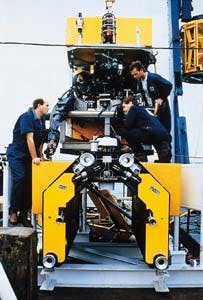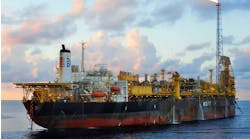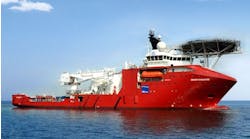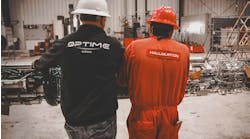The Pipe-mate pipeline tool can be interfaced to the tool rotation module and the spool docking module.As deepwater pipeline activity has increased, the need for a reliable, diverless pipe repair system has become paramount. Recognizing this, Sonsub, in conjunction with Saipem, has spent the past two years developing and testing a new Diverless Sealine Repair System (DSRS), which is to be tested this summer in 600 meters water depth in Italy's Gulf of Taranto.
The new system incorporates the tooling aspects of the Sonsub remote pipeline repair system with a specialized sealing system appropriate for remote diverless subsea pipeline connections.
The repair system is based on two Advanced Remotely Operated Work Systems (AROWS - Triton or MRV) with an optional eyeball type observation vehicle. On each of the AROWS an isolated hydraulic power unit (IHPU) is fitted to accommodate a dedicated hydraulic system supporting all subsea tooling.
Frictionless hot stabs are used to convey hydraulic power and controls to the specially designed tools, which include:
- Two handling frames that can lift the pipe or move it sideways. These are operated by the AROWS independently of the crane vessel used to install them. Following lifting of the pipe from the seabed, and cutting of the damaged section, the pipe ends are then aligned by the frames' lateral and vertical movements.
- Two water-inflatable pipeline support trestles improve this alignment capability. These are moved around the seabed using ROV-operated winches. Bollard clump weights are employed to re-route the winch wires in order to adjust the pipeline's position and, if necessary, remove the severed section of damaged pipeline.
- A diamond wire cutting module, capable of cutting 26-in. OD, 25.4mm pipe, is powered by the ROV's IHPU. A taut wire system, also operated by the ROV, provides precise measurement of alignment of the pipe ends
- Two Pipemate general purpose universal pipeline tools which can be interfaced to, and allow precise axial positioning of, both the tool rotation module and the spool docking module. The tool rotation module is used primarily for precise circumferential rate feed control and to carry the grit entrained cutting system
- The pipeline replacement spool is equipped with a subsea buoyancy system, to allow easy maneuvering of the spool by the ROV without dependence on surface lift.
- A Pipe-end Preparation Tool (PPT) is used to square the pipeline end for the spool connection, with a pipeline scissor clamp for removing the damaged section from the site
- An ROV-mounted dredging system and water cutting system is supplied by specialist contractors.
X-Loc connector
One of the most critical elements of the DSRS is the connector system used to provide the requisite connection and to seal the repair spool to the pipeline. Sonsub required a compact, relatively lightweight connector that would provide a true metal-to-metal seal/connector capability and could be easily operated and activated by an ROV. As a suitable connector was not available, Sonsub developed the X-Loc connector.
This system is being adapted under different projects for pipe diameters from 6 inches to 36 inches. The connector is unaffected by water depth and can be manufactured to suit any class of pipe, including specialized pipelines used for transporting highly corrosive product. It is available in various configurations, which in the case of the DRSR project comprises a floating ball end (misalignment) connector with a telescopic joint for extension capability.
As the X-LOC seal rings are inflated, weakened sides of the X-LOC expand out, forcing the inner circumference against the pipe's outer surface. The resultant high force ensures, by means of suitable `lips', the necessary sealing and grip. Inflation pressure is provided through hot stab by the ROV-mounted IHPU intensifier.
Following initial trials in a protected shallow water site this spring, final deep water trials are expected to be held shortly in the Gulf of Taranto offshore Capo Trionto. The full-scale repair scenario should employ a 200 meter long, 26-inch OD pipe string laid on the seabed. Then repair of a pipe section should be performed using a Saipem support vessel, two AROWS systems and the full DSRS spread and crew.
Assuming trials are successful, Sonsub's next step is to market the DSRS as a total pipeline repair system available to the offshore industry as an `off the shelf' service. Another target is adaptation of the system to handle ultra-deep waters over 3,500 meters down, as would be the case with the Oman-India project.
Copyright 1995 Offshore. All Rights Reserved.




